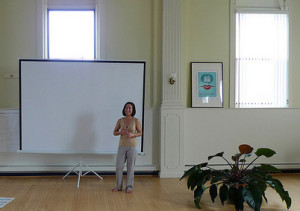Your screen and your projector
 The screen you choose is as important as your projector
The screen you choose is as important as your projector
The type of screen you need depends on your projector, the amount of light in the room, the size of the room and the viewing angle distance from the screen.
The first step is learning about the various types on the market to suit both your budget and projector. There are four basic types:
- Electric
- Permanent, fixed frame
- Manual pull down
- Portable
Electric
Definitely the most convenient and easiest to open, the electric screen is also the most expensive. They are also the most versatile and can be mounted on the ceiling or on the wall. Electrics can be hung externally on the ceiling or put into a recessed ceiling. They can come up out of the floor or down from a wall adding a instant “wow” factor. They are much more difficult to install than other types of screen since they require a power source to operate. Definitely the screen for a professional look.
Permanent
If you have a dedicated space for your projector where all your viewing takes place, such as a conference room or a family recreation room, then a permanent screen may be the best option. It resembles a flat-panel TV wrapped in a metal or plastic-frame. Lightweight and flexible, a fixed-frame projector screen can be mounted on almost any wall. It’s usually installed directly onto the wall with curtains in front for both protection and concealment. After the initial set-up, there is nothing needed. More expensive but easier to use.
Pull Down
If space is limited, then you may choose to install a pull down. These manual pull-and-release types are typically seen in classrooms and conference rooms but also work well at home. It’s usually a semi-permanent mounting on the wall that fits above paintings or other decorations. When the screen is pulled down to the desire height and locked into place, it simply covers the permanent wall behind. When not in use, it’s rolled up into its protective housing. Since it’s usually mounted on the ceiling instead of on the wall, it can be easier to install and not as expensive as other screens.
Portable
Portables are also known as tripod screens since they have three-legs. These are the most economical option and also the easiest to transport. They make sense if you need to set up in a different room or are travelling with your presentation to conferences and other venues. If your projector is portable, then a portable makes sense. While they cost less, the major drawback for portable screens is that you must adjust the screen and get the correct screen aspect ratio every time you set up.
Once you have decided on which type you would like, you’ll want to consider the type of fabric and size.

Leave a Reply